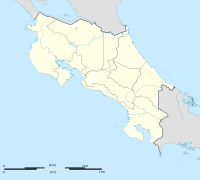Cahuita
Cahuita is a village with about 3000 inhabitants on the Caribbean coast of the Central American state of Costa Rica . It is about 43 km southeast of Limón and 15 km north of Puerto Viejo . The place is one of the centers for individual tourism in Costa Rica. In 1991 the area was largely destroyed by an earthquake .
Cahuita is home to the country's second oldest national park , home to howler monkeys , capuchin monkeys and sloths , among others . The land area of the park covers approximately 1068 hectares .
Cahuita National Park (Cahuhita)
The coral reef around the well-known tourist town was raised by almost a meter by the great and severe earthquake in 1991, and the sewage contributed to the destruction. A few sticks still exist, but only the fishermen can take you there.
One can observe u in the national park. a. Helmet basilisks . Adult males have cartilaginous head, back and tail combs that can be raised in case of danger and territorial / dominance behavior in order to look impressive and dangerous. They are joined by the green iguana , which looks threatening at up to 55 cm, but is also harmless. The helmet basilisk is equipped with long legs and skins between the toes. He can cover considerable distances on the surface of the water at a speed of up to 12 km / h, which is why they are also known as the "Jesus Christ Lizard" in English. White-shouldered capuchin monkeys and coat howler monkeys can be seen in the trees. Leaf cutter ants carry pieces of leaf to their colony in order to supply their mushroom gardens, on whose fruiting bodies they actually live. Tree termites form impressive nests, which with their cancerous growths are reminiscent of tree trunks in western latitudes. In the undergrowth you can come across the crab raccoon with its light brown, black ringed tail. Hundreds of thousands of beige land crabs have buried themselves everywhere. The beautiful heliconias used to belong to the banana family , but are now managed in their own plant family with only one genus and 100 to 150 species. Of these, 30 occur only in Costa Rica ( endemic ). The wild pineapple is one of the best-known bromeliads . The now pandemic tree of travelers (Fam. Musaceae ) actually comes from Madagascar . There is a nice, but not applicable variant of the origin of its name: the huge fan-shaped leaves move in the wind like a waving hand that seems to greet or say goodbye to a traveler from a great distance. In reality, the banana-like perennial - even if it looks like a palm tree - got its name from the natural 1½ l water reservoirs at the base of its leaf axils, which can supply the thirsty. However, the water is mostly polluted and only suitable for an absolute emergency. Beautiful, blue blue morpho butterflies do not have colored scales, but microscopic grooves that only reflect the blue light. This means that the color cannot be "rubbed off" like other butterflies.

